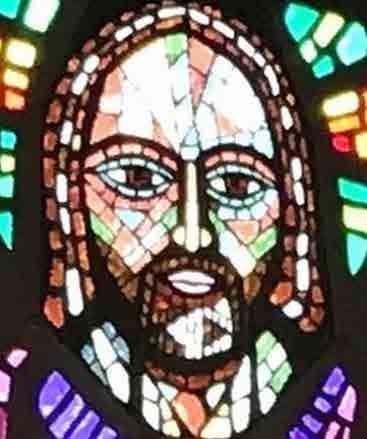
3 minute read
The Buckfast Abbey Chapel Window and the Shroud of Turin
An Image of Redemptive Suffering
By Mackenzie Robinson
Visitors to the Blessed Sacrament Chapel at Buckfast Abbey are always struck by the impressive floor-to-ceiling stained glass window of Christ, offering his body and blood in the Eucharist. Many puzzle over the seemingly abstract choice of colours - the face, for example, contains a mixture of reddish-brown, green, blue and more.

However, a comparison with the face in the Shroud of Turin reveals that there is nothing abstract about the choice of colours. The similarities between the two images are so close that the monk who created the stained-glass window, Dom Charles Norris, must surely have been influenced by the Shroud image.

Look first at the reddish-brown areas of the face in the window. Both eyes are surrounded by this reddish-brown glass, the left eye more than the right. Forensic pathologists who have studied the Shroud of Turin point out that the area around the left eye is considerably swollen, possibly suggesting a broken cheekbone, likely to have closed the eye. The area under the right eye is also swollen, but less so. The use of reddish-brown glass in the window therefore seems to replicate the injuries shown on the Shroud.
The similarities do not end there. The face of Christ in the window has an odd white patch in the beard. Comparison with the Shroud shows a similar appearance, where part of the bloodstained beard was pulled out by Christ’s torturers prior to the crucifixion.
The face also appears to record a similar pattern of bloodstains from the Crown of Thorns. Note the distinctive ‘3’ shaped bloodstain on the forehead of Christ in the Shroud, and then note the position of the prominent red-brown glass section in the window, with its small lower drip of blood also present. The other bloodstains on the forehead of the Shroud image have similar echoes in the face of Christ in the window.
Next look at the hair in the Shroud image. As a result of the rigours of the Passion and Crucifixion it would have been matted with sweat and blood into the rigid strands visible in the image. The head of Christ in the window has a similar appearance, even down to the shape of the hair where it meets the shoulders. The trickles of blood through the hair, which appear white in the famous ‘negative’ image of the Shroud, correspond to the sections of white glass in the window.
Turning to the arms, we see further similarities between the two images:

Some have observed that the use of straight lines of coloured glass on the forearm gives the odd impression of the arm being almost octagonal in shape. However, comparison with the Shroud shows that the use of red-brown glass is once again a portrayal of blood flows, and the area of colour in the palm of the hand is the location of the nail wound (the exit wound on the Shroud appears to be at the wrist, but it has been pointed out that the entry point may have been the base of the palm, with the nail being driven in at an angle). It has been commented by forensic pathologists that the direction of blood flow, down the forearms of the man in the Shroud, is one of the most convincing details suggesting the Shroud’s authenticity. The same feature is clearly visible on the arms of Christ in the window.
The image in the window of the Blessed Sacrament Chapel therefore seems to be less an abstract use of colour, and more an accurate portrayal of Christ’s Passion – a reminder that the light of the resurrection only comes to us through the darkness of His suffering. To those who can visit Buckfast Abbey this Easter, the window will be a moving and powerful reminder of the reality of the event on which our faith is based.
(Mackenzie Robinson is an Oblate of St Mary’s Abbey, Buckfast, the Director of St Benedict South West (www.stbenedict.co.uk), and lectures on the Shroud of Turin).










